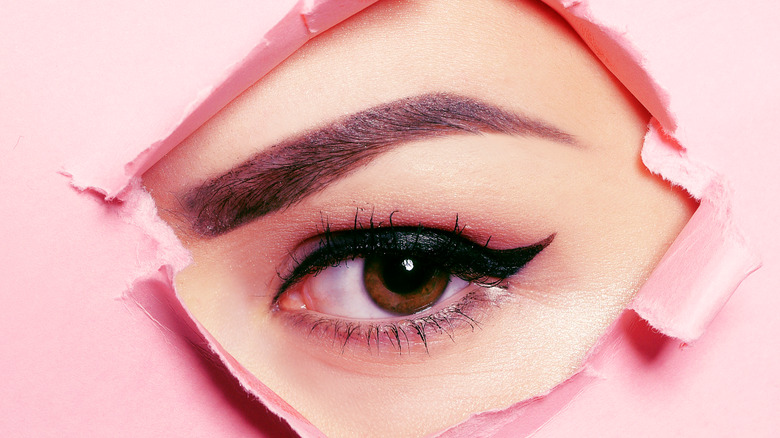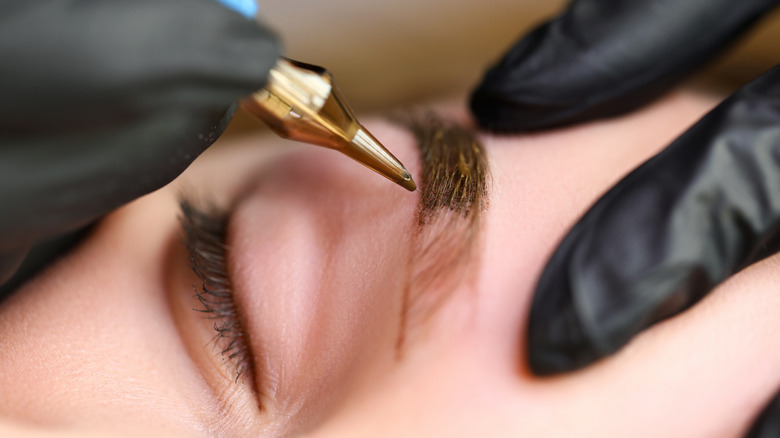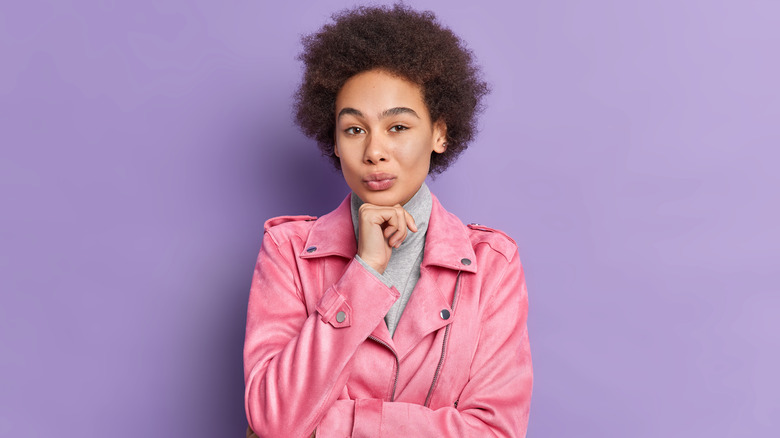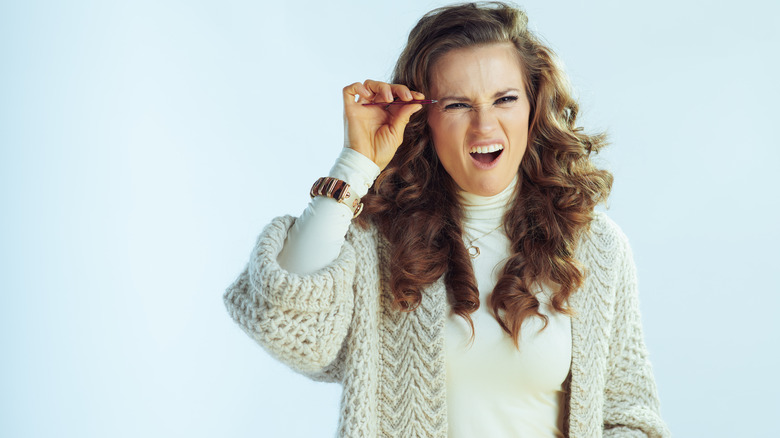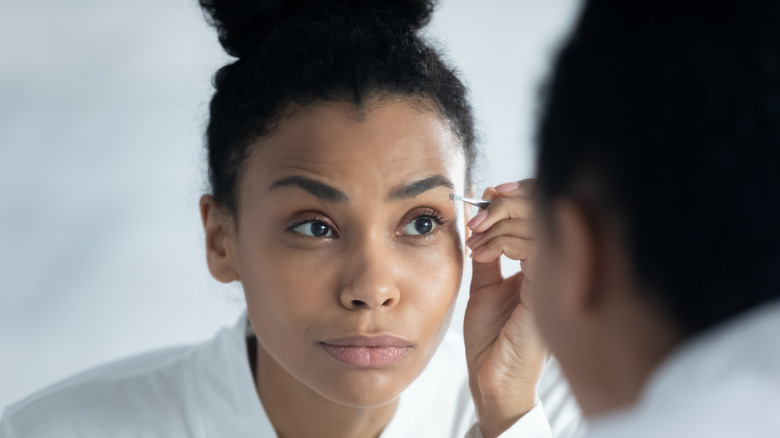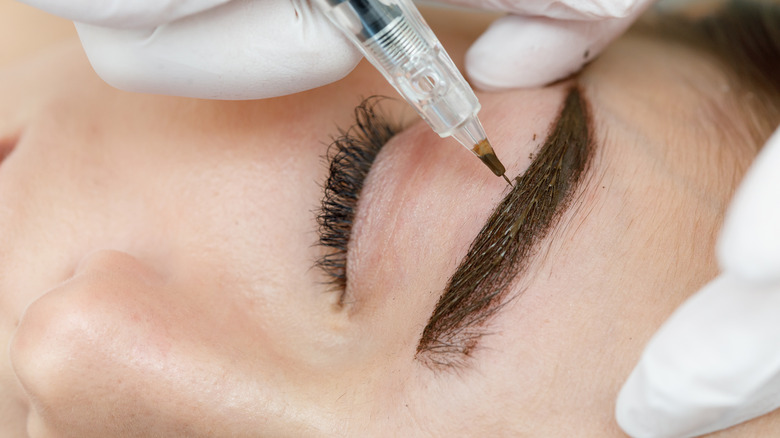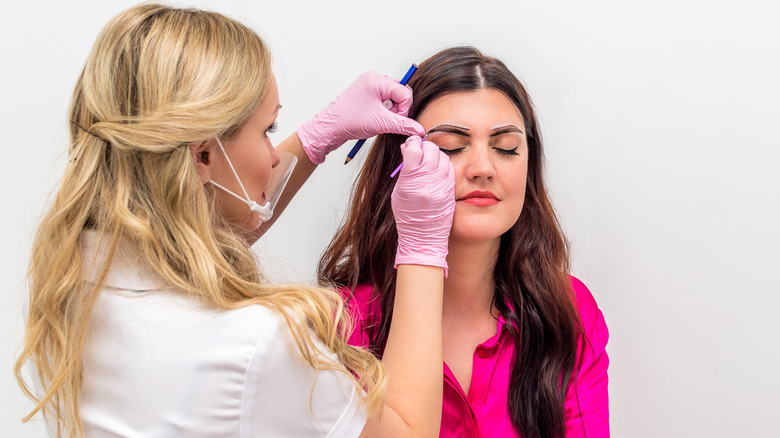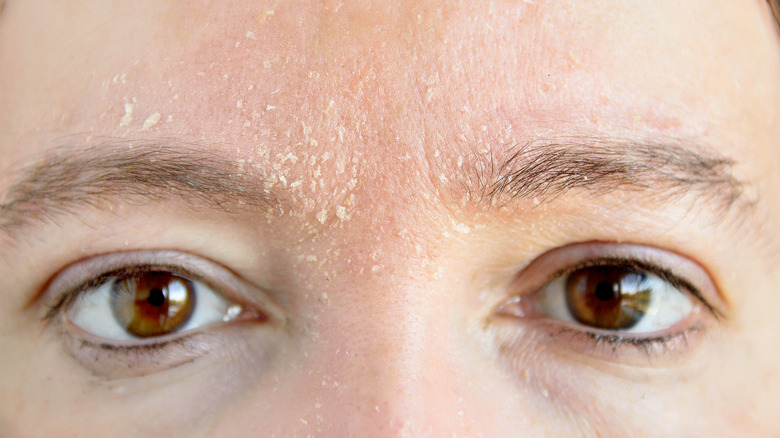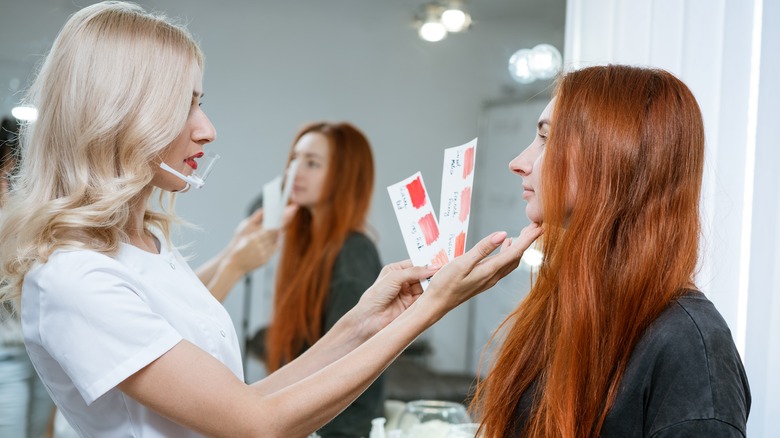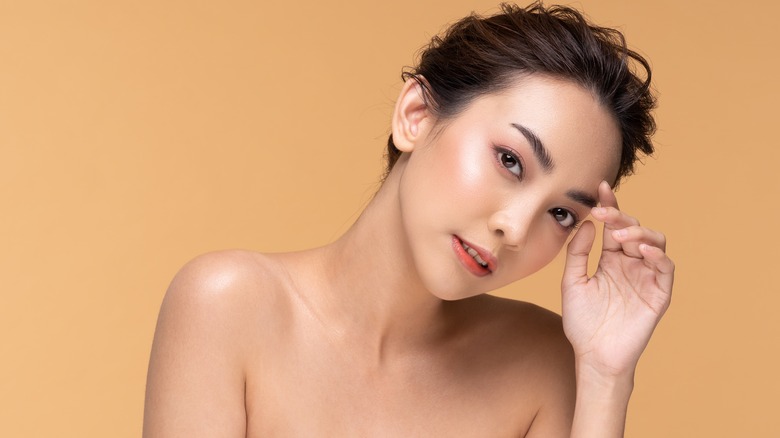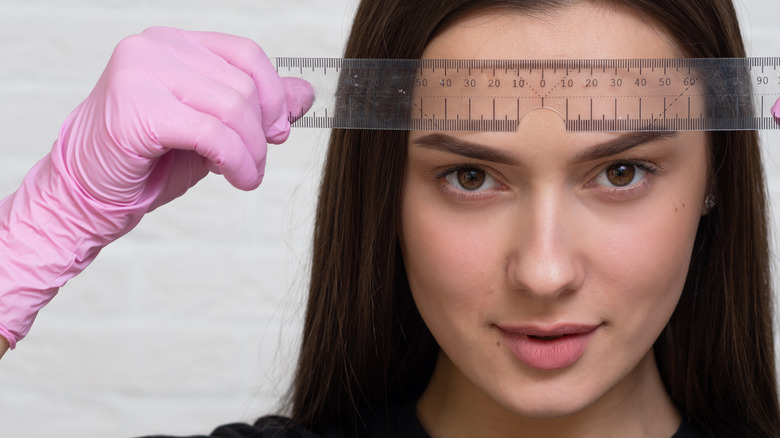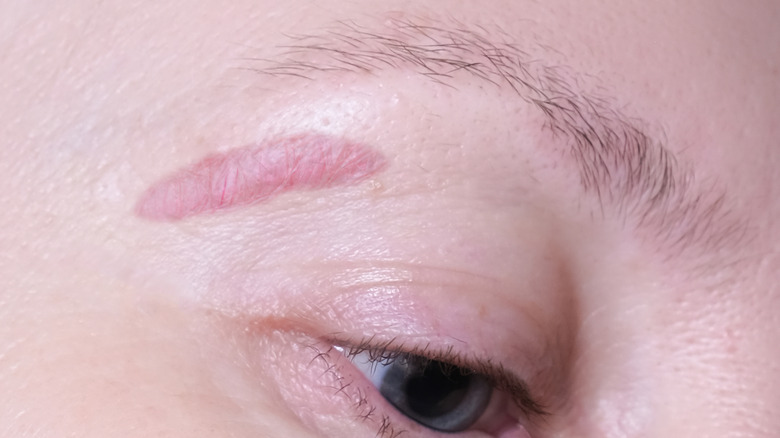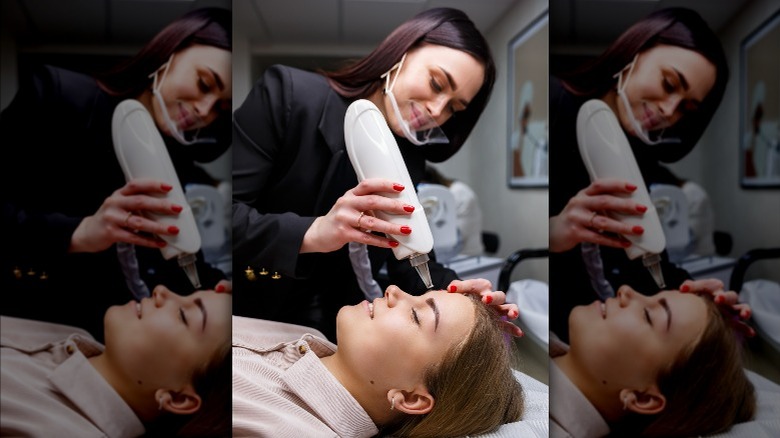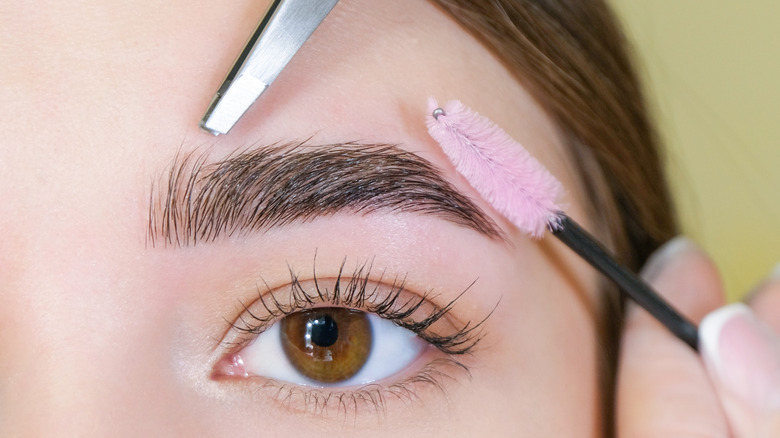What Is Microblading And Does It Hurt?
We may receive a commission on purchases made from links.
Microblading took the world by storm a few years ago, and with good reason. Full, bushy eyebrows became very popular, and the look is pretty hard to achieve with just an eyebrow pencil, especially if you have super thin brows, to begin with (if you plucked your brows to a thin line in the noughties, we feel you). Then there's all the time filling in your eyebrows take up in the mornings, especially when you need to put in some extra work to make them look bushy. Tinting your eyebrows is one way to free up more time in your morning routine, but if you hate having to do monthly touch-ups, microblading saves you a lot of time and effort (via Elle).
While microblading can benefit pretty much anyone, cosmetic makeup expert Sophia Wyatt says it's a great treatment if you experience hair loss in your brow area or notice the tail end disappearing. Those who have noticeable asymmetrical eyebrows can benefit from microblading as well. Even if you lost all your eyebrow hair due to a medical condition like Alopecia, you can still benefit from this treatment. For most, however, microblading serves as a means to sport amazing-looking brows 24/7 without lifting a finger in the mornings (via Sophia Wyatt Aesthetics).
If microblading seems like the miracle treatment you've been waiting for your whole life, read on for everything you need to know about the procedure and whether you can expect any painful side effects.
What is microblading?
Microblading is the holy grail for achieving that bushy brow look because the procedure involves tattooing extra eyebrow hairs onto your skin, according to Medical News Today. You'll notice that your brows look darker and fuller almost instantly post-treatment. If done right, no one will be able to notice that the extra hairs are not your own. However, some people might need more than one microblading treatment to get the look they desire, and in some cases, touch-ups are needed a few weeks after the initial treatment.
Brow expert Suman Jalaf described microblading as "a type of eyebrow architecture" to Elle, adding, "The process is very precise thanks to the tool that is used which is effectively like a pen with the nib being a sloped blade with 10-12 little needles at the end — needles that don't penetrate the skin but just delicately scratch the surface, much like a paper cut." The end result is natural-looking hair-like strokes that fill up your eyebrows, making them look fuller. According to Jalaf, the best eyebrow shape for each person differs, so it's crucial you get microblading done by someone who knows what they're doing.
Is microblading for everyone?
While microblading is usually a pretty safe treatment, it isn't for everybody, and no, the amount of eyebrow hair you have isn't really a factor. Your skin type, however, has a huge impact on whether or not you're a good candidate for microblading.
"I try to warn patients against microblading if they have sensitive skin or if they're prone to allergies with other types of topicals," dermatologist Tracy Evans, M.D., told Cosmopolitan. If you think you can wing it, think again — Evans says that those with super sensitive skin are more susceptible to contact dermatitis, and you can end up with a scaly, cracked rash post-treatment. Suppose you suffer from skin conditions like keratosis pilaris, pesky breakouts, or even cystic acne around your brow area. In that case, microblading is also not the best idea since these conditions can complicate the healing process. Microblading can also cause these skin issues to flare up. Oily skin is another dealbreaker because it'll make the pigment fade faster. If you don't suffer from any of the above-mentioned conditions and still get a reaction, Evans says you must pay a visit to your dermatologist. They can prescribe steroids to ease symptoms and prevent any damage to your brand-new tattooed eyebrow hairs.
Speaking to Dermstore, esthetician Liz Carey explained that pregnant and breastfeeding women should also steer clear of microblading as well. You also can't undergo microblading while getting chemotherapy since you have a much higher risk of getting infections.
Microblading is best for people with thin eyebrows
Yes, microblading can be great for practically anyone, but those with thin eyebrows will benefit the most, brow artist Alixandria Capparelli told Cosmopolitan. She added that those with barely any eyebrow hair might find that the microbladed hairs don't look as natural as they'd like. Luckily, there's a fix for this: Ask the technician to add some shading to the strokes to create the illusion of more hair in between the drawn-on strokes. This way, empty spaces won't be as obvious, and the overall look will be more natural.
If hair loss isn't one of your concerns and you simply have thin eyebrows needing some volume or enhancement, microblading can create a very natural-looking bushy brow, Capparelli says. Suppose you already have bushy brows but would like some added definition or a more groomed look. In that case, Capparelli suggests you opt for other treatments like eyebrow lamination or a brow gel instead — microblading will simply make your brows look fuller, but it won't do anything to make them look more groomed. However, according to brow technician Jodi Muraski, who works at Washington Microblading, having thick brows doesn't mean you won't benefit from the treatment at all. It can still help you shape your brows if you're tired of regularly tweezing them into submission. "Whether you're looking to achieve a rounded look or prefer a more drastic arch, microblading can help you get the look you want," Muraski says.
How long does microblading last?
One of the main reasons most people likely consider microblading is because it's semi-permanent, and you'll have eyebrows that are on fleek for several months without lifting a finger. If done right, microbladed brows can last up to a year, Diana Menendez, who owns a threading and microblading studio, told Allure. The good news is that your brows won't have completely faded after a year; you'll need touch-ups to maintain the original microbladed look. If you don't undergo any touch-ups, the look will fade completely over three years, which is good news for those who end up not liking their brows after a while.
While the fact that microblading can last a year is amazing, Menendez says that some people might notice the pigment fading faster if they have regular chemical peels or use medication like tretinoin to treat acne. "Glycolic acid, microdermabrasion, and chemical face peel products should be kept away from the tattooed area even after they are healed as continued use could lighten the pigment," restorative tattoo artist Shaughnessy Otsuji says.
If you have oily skin, you might also need more regular touch-ups because it can make the pigment fade faster, master artist Daly Beneche told InStyle, adding that sun exposure and the products you use on your face all play a major role as well.
The difference between microblading and tattooing eyebrows
You're probably curious about the difference between permanently getting your eyebrows tattooed and microblading, and the difference lies in the ink used and how deep it penetrates your skin.
"Microblading, unlike tattooing, is not in the deep layer of skin, but more on the surface," microblading expert Suman Jalaf told Elle. She added that you'll immediately hear the difference as soon as the technician starts their work — instead of the signature buzzing sound you usually hear when getting a tattoo, you'll hear a scratching noise instead. This is because microblading deposits pigment into the upper dermis of the skin, and this is one of the reasons it's not permanent, esthetician Liz Carey told Dermstore.
Another key difference is the type of ink that is used. "Tattooing is permanent and uses ink, which fades to a green or blue. Microblading is semi-permanent and uses pigment that fades into a natural brown color," aesthetician Kim Chang explained during a Q&A with the Baylor College of Medicine. Carey adds that your body eventually metabolizes the pigment, which causes it to fade.
Microblading vs microshading
While microblading and microshading might seem the same, there are a few key differences. Speaking to Elle, microblading expert Suman Jalaf explained that the critical difference between these procedures is the end results. If you're looking for a full yet soft brow, microshading will do exactly that. Microblading, on the other hand, creates that "super precise, individual hair look," as Jalaf puts it.
The application is also different. Jalaf explains that, instead of tattooing strokes that mimic eyebrow hair, microshading involves tattooing small dots in the brow area. This creates more color and volume but isn't as defined as microblading. If you don't know how to choose, Jalaf says not to worry. Technicians would usually combine these two methods to ensure your eyebrows look as natural as possible.
Both these treatments are semi-permanent, but microshading doesn't last as long as microblading, according to Healthline. You can expect it to look amazing for around three to six months, whereas microblading can easily last eight months or more. Microshading, however, is usually much kinder to sensitive and oily skin.
Is microblading painful?
None of us like experiencing pain, and few really want to believe that it's painful to be beautiful — and it doesn't have to be, not even when you're basically tattooing small hairs onto your eyebrows.
"It absolutely does not hurt," master artist Renee Lee told Prevention, adding, "We've mastered addressing the pain during the procedure and strive to make the entire process as comfortable and relaxing as possible." This is done by applying a numbing cream to your brows prior to the procedure. "It doesn't hurt as such, it is more a sensation," microblading expert Suman Jalaf told Elle, adding that people often find the sound the microblading tool makes much worse than the actual treatment. Lee added that a pain-free procedure is another reason you should make sure you go to a technician who knows their stuff.
According to Healthline, some people report feeling very minor discomfort during the procedure. The sensation is not the same as getting a tattoo so you can rest easily. How much discomfort you ultimately experience will depend on your pain threshold. You will, however, likely experience some discomfort after the procedure — swelling and pain are usually pretty common. Lee says that an over-the-counter painkiller will do the trick if the pain bothers you.
How much does microblading cost?
Brace yourself: Microblading is not a cheap treatment by any means, and if you want eyebrows that are gorgeous permanently, it's going to cost you (but we'd like to mention that it can be worth it).
What you'll pay for a microblading treatment will depend on many factors. According to Cosmopolitan, your location and the technician's experience all play a role, and you can expect to pay anything from $500 to $2,000 per treatment. According to Allure, most microblading sessions typically range between $400 to $1,400. The final amount typically depends on whether you're just going for a touch-up or getting the treatment for the first time.
The technician's experience is usually the biggest factor in pricing, master artist at Arch Angels NYC told InStyle. "At Arch Angels NYC, microblading starts from $600," she says, adding, "We have three different artist skill levels and tier our pricing accordingly." There are three different skill levels, Beneche explains: senior artists, royal artists, and master artists. Senior artists have one to three years of experience and a price point of around $600 per session. Royal artists have performed the procedure for four to six years and typically charge around $700. Master artists, on the other hand, are those who have over ten years of experience in microblading, and you can expect to pay around $1,000 per session.
Can microblading cause any lasting damage?
We'll admit that tattooing even the smallest of hair strokes on your face can be incredibly daunting. Unlike unflattering tattoos on the rest of the body, you can't hide a microblading session gone wrong.
The main concern for most people regarding microblading is the fear that the treatment might cause scarring or even permanently damage eyebrow hair follicles. Still, experts say that going to a qualified technician can help prevent any long-term damage. "When performed properly, microblading should cost minimal damage to your natural eyebrows," Joshua Zeichner, M.D., told Prevention, adding that mistakes like ingraining the pigment way too deep into the skin or not using sterilized tools (which then leads to infection) can cause long-term damage to your hair follicles. If you go to an experienced technician, however, you won't face any of these problems and might experience enhanced hair growth, esthetician Liz Carey told Dermstore.
As for dealing with scar tissue, it's unlikely that you'll have any permanent scarring if you go to a qualified technician. Speaking to Cosmopolitan, brow artist Alixandria Capparelli explained that scar tissue only forms if a technician cuts too deep into your skin. If you develop an allergic reaction after getting your brows microbladed, Capparelli says you must get medical treatment right away since the rash or infection that follows could stunt new hair growth.
How to prepare for your microblading appointment
Once you decide to take the leap and get your brows microbladed, you must ensure you prepare for the appointment the best you can. There are some products and treatments you need to steer clear of beforehand to ensure the treatment is a success, board-certified dermatologist Jeanine Downie, M.D., told Women's Health.
First, don't apply spray tan to your face before treatment, and don't wax your eyebrow area. This can lead to irritated skin and even cause the results to fade faster. Some beauty products are off-limits before a microblading treatment. Feathered eyebrow expert Kristie Streicher says that chemical exfoliators should be avoided for up to two weeks before your microblading appointment because they can cause unwanted skin irritation. This means you'll have to temporarily shelf products containing retinoids or alpha hydroxy acids.
You should also double-check the meds you're taking. Streicher says that any blood thinner or aspirin should be avoided one week before your microblading appointment. Failing to do so can lead to excessive bleeding during the procedure, which, in turn, will prevent pigment from being absorbed by your skin. You should steer clear of alcohol for around a week before your appointment for the same reason. However, you can take some Tylenol beforehand if you'd like to take extra precautions against possible pain during the procedure.
What to expect during your microblading appointment
First of all, the microblading technician will sit down with you for a consultation. This is your chance to ask them any questions, and if you have any fears or concerns, let them know. Once they've put your mind at ease, they will explain exactly what they're going to do, after which you'll have the opportunity to choose the color and style you want for your brows. The technician can help you with these choices and recommend specific colors and styles if you are unsure, per Medical News Today.
The good news is that even though a microblading appointment can last up to two hours, you're not actually subjected to the blades for the entirety of that time. "The whole process is very quick – it's actually the numbing which takes most of the time (50mins); you aren't under the needle for the whole two hours," microblading expert Suman Jalaf told Elle. Once the numbing cream has taken effect, the technician will use a dark pencil to draw your desired brow shape (via Cosmopolitan). After this, the microblading process will start in full swing. The technician will draw a few hair strokes and then numb the area again. This process repeats until they are finished, brow artist Alixandria Capparelli told Cosmopolitan. Post-treatment, your eyebrows might look shockingly dark — but don't panic. This is normal, and you'll see the final (and lighter) color set in within 10 to 12 days.
What does microblading aftercare look like?
How you take care of your brows after a microblading session determines how good they'll look and how long the pigment will last.
You can expect some scabbing to start a few days after the procedure, master artist Daly Beneche told InStyle. Keep applying the cream the technician provided until the scabs fall off. While you're healing, there are a few things you need to steer clear of. "During [the healing period], you should avoid working out (excessive sweat), submerging your face in any water, and applying any cosmetics on the brow," esthetician Liz Carey told Dermstore. Healing can take up to a month. Once your brows are fully healed, you'll see the pigment's true color. This is usually when you can go in for a touch-up, if necessary, master artist Renee Lee told Prevention.
Once your brows are fully healed, you should steer clear of applying retinoids and AHAs to your brow area, Carey says, adding that because these compounds encourage skin cell renewal, they will make your brows fade faster. Applying a good sunscreen is also paramount since sun exposure can not only cause the pigment to fade faster but can also cause it to change color. "The sun hitting your face will change the color of the ink sometimes to look orangey, blue, and I've even seen pink," brow stylist Joey Healy told Allure. Better load up on that SPF 50!
How to decide on an eyebrow shape and color
The color you choose for your microbladed brows needs to look as natural as possible, and according to MicroBladers, choosing the right color is not nearly as complex as you think.
The technician can help you make the right choice by using your natural hair color and skin tone as a guide. As a rule of thumb, dark-haired people (brown or black) will usually look great with a color that's a shade or two lighter than their natural hair color. Those with lighter hair, like light brown or blonde, typically need to go two shades darker to ensure the microbladed eyebrows don't fade into the background. For redheads, technicians usually opt for a light brown or blonde color. It's essential to keep in mind that you should never use a color that matches your hair exactly.
You're free to bring images of what you envision for your brows, microblading expert Suman Jalaf told Elle. "[B]ut I'll determine the color and shape to use from my years of experience," she added, saying that many clients usually want darker brows than she would suggest. "[I]t's always better to go a little more natural – you can always add more into the top-up session for a darker color," she adds. Jalaf also considers each client's skin tone and eye color and uses a Microblading Ruler to determine the best shape for each client's brows.
What are the risks of microblading?
One of the downsides of microblading is that the pigment used is not regulated by the Food and Drug Administration, board-certified dermatologist Hadley King, M.D., told Allure. This means that allergies and contaminations are very real risks. "[T]he inks aren't tested, and I've seen a lot of complications, like infection, allergy, permanent scarring, and poor aesthetic outcomes," board-certified dermatologist Jennifer MacGregor, M.D., told Prevention. She adds that experiencing some redness and itchiness along with some crusting is normal while the area heals, but if you're dealing with swelling, pus, oozing, and pain, it's time to see a doctor because you likely have an infection.
According to WebMD, the ink could cause allergic reactions in some people, which can manifest as a rash. This is typically treated with antihistamines or steroid shots. Keloids are another risk. This condition occurs when your body creates more scar tissue than usual, and while it's not common for keloids to form on the face, you have a higher risk of getting them if you've had them before. There's also a risk of developing granulomas. This condition manifests as inflamed knots that form around an area where a foreign substance or object (like microblading pigment) is inserted. These knots can develop within a few months of the procedure, but sometimes they pop up years after. Doctors will usually prescribe antibiotics or steroids to treat this condition.
Can you undo microblading?
Microbladed brows can be quite a headache to remove if you don't like the results, not to mention expensive. "Immediate removal is impossible and requires expensive laser sessions," board-certified dermatologist Caren Campbell, M.D., told Allure. Not just any laser treatment will do, though. Campbell recommends picosecond lasers since they yield the best results, and you can expect to pay $300 to $1,000 per session. Yes, removing a botched microblading job might cost you more than the initial procedure.
Board-certified dermatologist Hadley King adds that a microblading session gone wrong also "cannot be easily covered up if it is done incorrectly." Campbell says she typically doesn't recommend microblading for this very reason. If you do not love the results, brow stylist Joey Healy says you might be able to remedy it with some makeup. "We find that we're giving clients a lot of brow powder to mask discoloration and to even out some wacky things that happen," he explains. He also sides with Campbell regarding microblading for cosmetic reasons only, saying that people tend to forget that trends come and go. "We're helping people right now recover from the '90s thin eyebrows," he explains, adding, "You are married to this shape. This isn't a lash extension; it is a face tattoo, and there is no way around it. It's a commitment." He also warns that people should remember that thin brows might very well make a comeback.
Where should you get microblading done?
Knowing where to get microblading done can be tricky. The best way to gauge if an artist is trustworthy and experienced is to see their work for yourself. The Brows Academy recommends you check out the artist's social media pages and website portfolios. Doing sufficient research will help you make the best decision. Look for reviews online — are people happy with their brows, or are many complaining about the results? Something else you need to pay attention to is the technician's training. What training did they have, and where did they get it? Board-certified dermatologist Hadley King, M.D., told Allure that licensed aestheticians who have accreditation from the American Academy of Micropigmentation or the Society of Permanent Cosmetic Professionals are usually your best bet because their training is typically more extensive.
Eyebrow expert Kristie Streicher told Women's Health that regulations for microblading salons and technicians vary from state to state, adding that in California, technicians are required to have a microblading certification in addition to being a certified body art practitioner. The county health department also needs to approve the salon. Board-certified dermatologist Jeanine Downie, M.D., says not to trust too much in certifications because microblading still isn't being appropriately regulated, so the best thing you can do in the end is to listen to what others say about a technician or salon. "Ask your friends that have been satisfied and monitor their results a couple months after," she advises.
Microblading alternatives
If you want eyebrows that look amazing but don't want to or can't opt for microblading, there are alternatives you can consider.
If oily skin keeps you from getting microblading, PMU Hub suggests you try nano brows. Nano brows are drawn using a machine instead of a handheld tool and consist of tiny dots being pierced into the skin instead of small scratches. This treatment holds up very well for those with oily skin, and the strokes also tend to look finer than with microblading. Microshading is another option. This treatment can fill in the gaps between your brow hairs, making them look fuller. Powder brows are another option and basically the same as microshading, except for the fact that it's always done with a machine. While it doesn't provide the same defined look as microblading, it can still give a fuller brow look.
If you don't want to cut into your skin, there are also some non-invasive eyebrow treatments you can consider, like brow lamination. This treatment has become increasingly popular and doesn't require the technician to make any incisions in your skin. Instead, they use a setting solution to lift your brow hairs, creating thick arches and fuller brows. This treatment is usually combined with tinting and can last around six weeks. Another option is henna. Coloring your brows using this compound can give them a fuller look that lasts about six weeks and only takes 30minutes.
